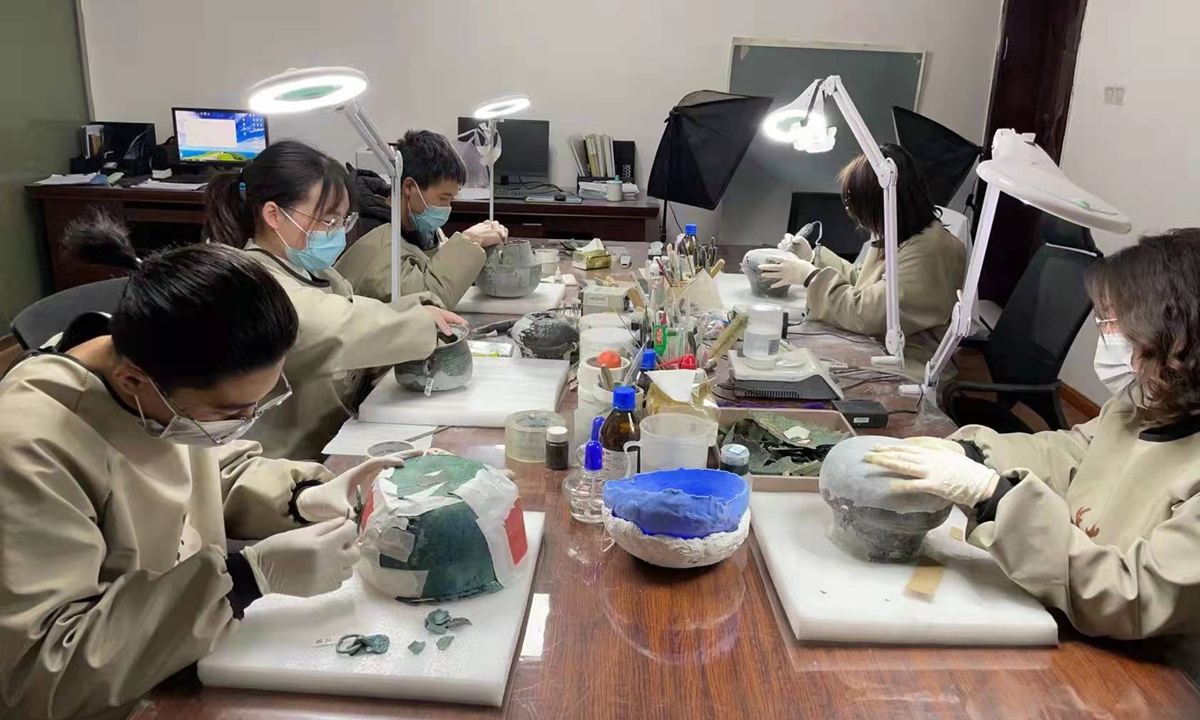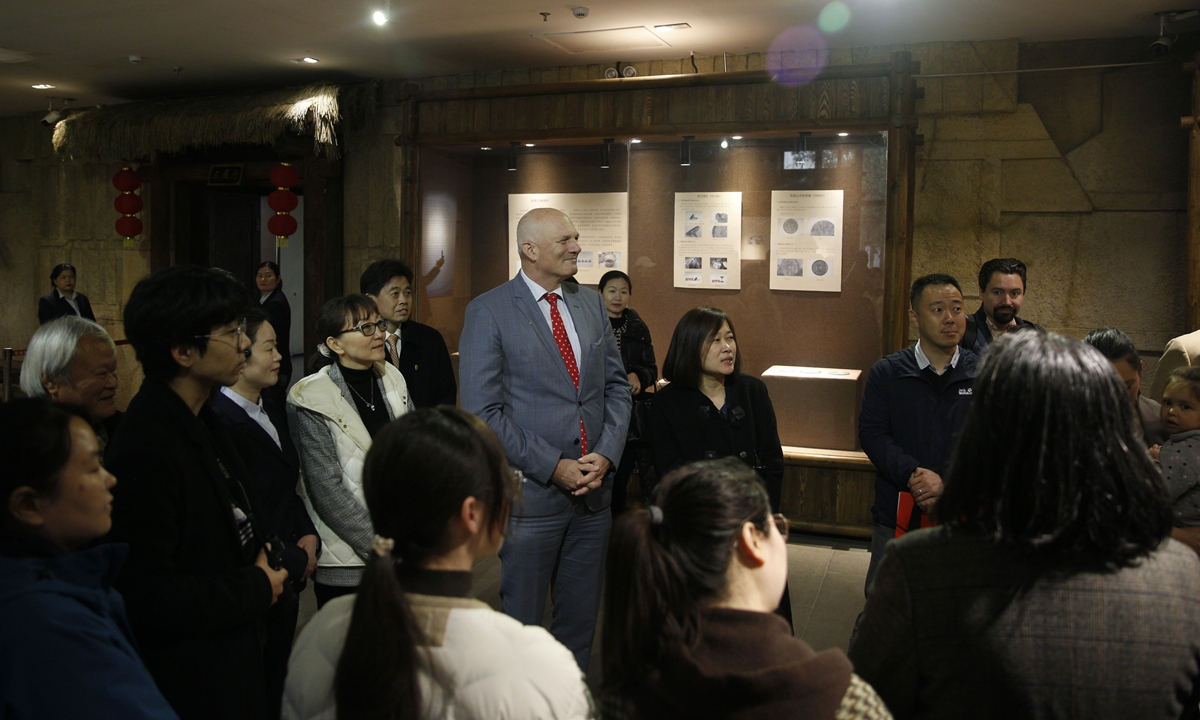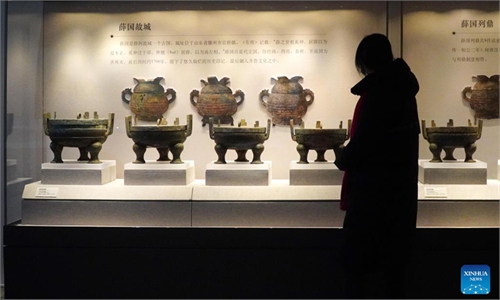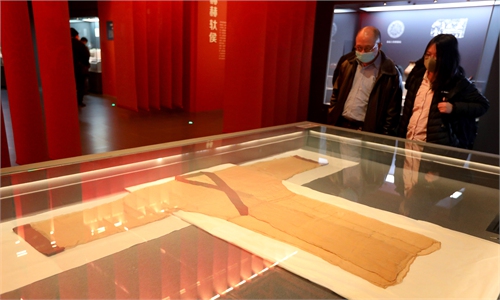ARTS / CULTURE & LEISURE
China, Switzerland cooperate to revive relics at unique museum

Experts from the Chinese Academy of Cultural Heritage restore corroded metal relics at Liye Qin Slips Museum. Photo: Courtesy of Ma Jingyu
Twenty years ago, the ancient city of Liye in Longshan county, Central China's Hunan Province, became famous after a number of wooden slips from the Qin Dynasty (221BC-206BC) were unearthed there. Archaeologists once even found a wooden slip with a multiplication table written on it; this remains the earliest and most complete multiplication formula table ever found in China to date.
Now, this medium-sized mountainous county is home to 94 rare cultural relics that have been restored to their original luster through the active participation of an "international team" at the Liye Qin Slips Museum, China's only museum dedicated to the history and culture of Qin Dynasty bamboo and wooden slips.
On Friday, the batch of metal artifacts unearthed from Liye, restored by experts from the Chinese Academy of Cultural Heritage with funding from the Swiss Federal Office of Culture (FOC), were presented at the Liye Qin Slips Museum. That same day, the Movable Cultural Relics Institute of the Chinese Academy of Cultural Heritage - Liye Working Station was officially established, signifying that local cultural heritage conservation and research work has taken a new step forward.
Timely heritage restoration
Located in the Liye Basin in northwestern Hunan, the well-preserved Liye ruins encompass three ancient city sites and tombs dating from the Warring States Period (475BC-221BC) to the Qin and Han (206BC-AD220) dynasties. More than 8,000 cultural relics from the ruins are now part of the collection at the Liye Qin Slips Museum, including a number of pottery and bronze vessels.
"Most of the 94 artifacts we restored were excavated from these ruins and ancient tomb groups," Ma Jingyu, the leader of the heritage restoration team and an expert from the Chinese Academy of Cultural Heritage, told the Global Times.
The restoration was not easy as many of the relics, due to limitations at the time, had been damaged during excavation or further deteriorated while in storage.
At the time, experts surmised that some of the damaged relics could not be restored because they lacked accurate information about their type and size.
For several of these heavily corroded metal relics, a turning point came from cooperation between domestic archaeologists and the FOC.
"In 2020, I learned about the FOC's program for the restoration of movable cultural heritage. Figuring it was worth a try, I actively prepared the materials for an application. Finally, my application was approved and we were able to save this batch of relics, which makes me very happy," Ma said.
In order to better salvage these artifacts, the museum turned to archaeologist Long Jingsha, the main excavator at the Liye ruins. With his years of work experience, he drew upon archaeological typology to analyze the fragmented remains of the cultural relics to determine what they must have looked like when they were new.
"While giving full play to multidisciplinary cooperation in archaeology and other research, we continue to draw on new developments in materials and techniques to effectively solve the practical problems encountered in the conservation of these metal relics," Ma said.
The museum also converted the curator's office and conference room, the rooms in the museum with the best lighting and ventilation and the largest space, into a conservation and restoration lab equipped with specialized facilities and instruments, which greatly guarantees heritage conservation work for the long-term.

Swiss Ambassador to China Jürg Burri visits the exhibition of the restored artifacts on March 17, 2023. Photo: Courtesy of Ma Jingyu
Model for intl cooperation"We believe that cultural heritage belongs to all mankind. Most of Switzerland's tangible cultural heritages are well preserved, and Switzerland will continue to promote the protection of cultural heritage in partner countries including China," Swiss Ambassador to China Jürg Burri said during a visit to the exhibition of the restored artifacts on Friday.
Tehani Pestalozzi, head of the Culture and Media, Embassy of Switzerland in China, told the Global Times that the well-ordered cooperation between the Chinese Academy of Cultural Heritage and the FOC, a first for the FOC in cultural relic restoration program in China, will greatly help the restoration and protection of endangered cultural relics in the rural areas of western Hunan Province.
China and Switzerland have a long history of friendly cooperation in the field of cultural heritage protection.
On August 16, 2013, Switzerland and China signed a Bilateral Agreement on the Illicit Import and Export and Repatriation of Cultural Property. Pestalozzi noted that the bilateral agreement mainly regulates the import and export of cultural property and makes China one of 10 priority countries for Swiss funding for the restoration of movable cultural heritage.
At the end of 2020, the FOC offered China 100,000 Swiss francs ($108,460) for the restoration of the 94 heavily corroded metal relics at the Liye Qin Slips Museum.
"For a small museum far from large cities, this successful project with the help of international forces is a great attempt and worthy mode to protect unrated and endangered cultural relics," Pestalozzi said.
This also broadens the possibility for future protection and restoration of movable cultural artifacts through joint efforts by experts in different sectors, Ma noted.
Pestalozzi said she enjoyed her first visit to Hunan, which is similar to Switzerland with its beautiful mountains, impressive infrastructure and cultural diversity.
Pestalozzi said she was pleased to see that China's cultural relics protection agency not only was able to use their cutting edge technology and expert knowledge to restore the relics, but also helped to build up the local capacities of their colleagues.
After two years of effort, the Liye Working Station was launched, marking a milestone in the cultivation of professional talents in the region.
Long noted that the working station will introduce the most advanced equipment and technology at home and abroad for the protection and restoration of local movable cultural relics.



